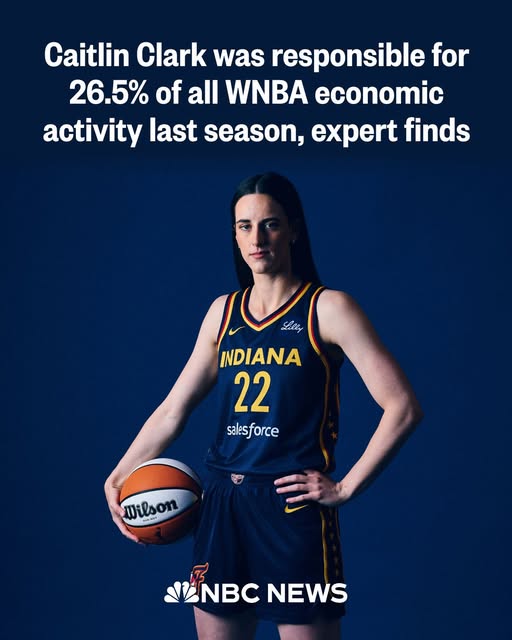Caitlin Clark isn’t just a phenomenal basketball player; she has become the economic powerhouse driving the WNBA’s growth in unprecedented ways. According to Ryan Brewer, an associate professor of finance at Indiana University Columbus and a respected expert in sports valuations, Clark was responsible for a staggering 26.5% of all WNBA economic activity last season. This impressive figure encompasses a wide spectrum of revenue streams, including merchandise sales, ticket purchases, and television viewership. As the WNBA continues to grow in popularity and visibility, Clark’s influence appears set to surge even higher in the coming season, with Brewer estimating her economic impact could easily surpass the $1 billion mark if current trends hold.
Clark’s rise has been meteoric, capturing the attention not only of basketball fans but also of sponsors, broadcasters, and the broader sports business world. In a league striving for greater recognition and financial stability, her ability to generate revenue and excitement has made her a pivotal figure in the WNBA’s ongoing transformation. But what exactly makes Caitlin Clark such an economic dynamo, and why is her impact so substantial compared to others in the league? To understand this, it’s important to explore several key factors that have combined to elevate Clark to this rarefied status.
First and foremost, Caitlin Clark’s extraordinary talent and style of play have captivated fans across the country and beyond. As a dynamic point guard with remarkable scoring ability, vision, and leadership, Clark has delivered some of the most electrifying performances in recent basketball history. Her ability to score from virtually anywhere on the court, combined with her clutch shooting and relentless energy, makes her an exhilarating player to watch. This on-court excellence translates directly into fan engagement, as more people tune in to watch her games, purchase her merchandise, and attend events where she appears.
The surge in ticket sales for games featuring Clark’s team is a clear indicator of her drawing power. Fans flock to arenas to witness her live, boosting attendance numbers and creating an energetic atmosphere that enhances the game-day experience. Higher attendance not only increases revenue from ticket sales but also positively impacts concessions, parking, and other ancillary income streams tied to live sporting events. The WNBA benefits broadly from this ripple effect, as teams can leverage increased attendance to negotiate better deals with sponsors and partners.
Television and streaming platforms have also seen a significant spike in viewership whenever Caitlin Clark is on the court. Broadcasters recognize that Clark’s presence attracts a wider audience, including casual fans who may not have followed the league previously. This increased viewership drives up advertising revenue and strengthens the WNBA’s negotiating position with networks for broadcast rights fees. In an era where digital streaming is becoming increasingly important, Clark’s ability to draw attention online further amplifies the league’s reach and marketability.
Merchandise sales provide another crucial piece of the puzzle. Caitlin Clark’s name and likeness on jerseys, hats, and other gear have proven to be among the top sellers in the league. Fans want to show their support and feel connected to the player who represents the excitement and growth of women’s basketball. These sales generate direct revenue for teams and the league, but they also contribute to brand awareness and long-term fan loyalty. As more people wear Clark-branded merchandise, the visibility of the WNBA expands in everyday life, helping to normalize and elevate women’s professional basketball.
Clark’s economic impact is also driven by her appeal to sponsors and advertisers. Companies eager to associate their brands with rising stars and positive role models see Clark as an ideal ambassador. Endorsement deals, partnerships, and sponsored content featuring her amplify the league’s financial footprint. For the WNBA, having a marketable figure like Caitlin Clark enables more lucrative corporate relationships, which in turn support league operations, player salaries, and community initiatives.
Ryan Brewer’s analysis highlights the broader economic implications of Clark’s presence in the league. Last season, with a standard season schedule, Clark’s economic footprint amounted to roughly 26.5% of all activity, a figure that is both astonishing and telling about her influence. Brewer projects that with an expanded season featuring 22 home games and modest inflation, this number could jump to $875 million. Given the momentum behind the league and Clark’s rising star power, surpassing the $1 billion mark this season is well within reach.
Such growth would mark a watershed moment for the WNBA and women’s sports in general. The league has long battled challenges related to exposure, funding, and respect in a crowded sports marketplace. Players like Caitlin Clark are helping to rewrite the narrative by proving that women’s basketball can be both thrilling and commercially successful. This shift not only benefits the current players but also paves the way for future generations who can dream of professional careers that are both financially rewarding and socially impactful.
Clark’s influence extends beyond just the numbers; she has become a cultural icon representing the increasing visibility and viability of women’s sports. Her success resonates with fans who crave authenticity, skill, and passion in their athletes. In a time when sports audiences are increasingly diverse and socially conscious, Clark’s story and personality help foster deeper connections between the league and its supporters.
Moreover, Caitlin Clark’s role in boosting the WNBA’s economic engine underscores the importance of investing in women’s sports infrastructure. From youth development programs to media coverage and corporate partnerships, the elements that support Clark’s rise are interconnected with broader systemic improvements. The league’s decision-makers and stakeholders are now more motivated than ever to capitalize on this momentum by expanding seasons, enhancing marketing efforts, and creating platforms that highlight the talents of players like Clark.
Her impact also challenges traditional assumptions about the commercial viability of women’s professional sports. By generating more than a quarter of the league’s economic activity, Clark defies the notion that women’s sports must remain niche or secondary. Instead, she demonstrates that with the right combination of talent, visibility, and investment, women’s basketball can thrive and become a central part of the sports landscape.
In addition to economic impact, Caitlin Clark inspires countless young athletes who see in her a role model and a trailblazer. Her success encourages participation at all levels of basketball, fueling the pipeline of talent that will sustain the WNBA for decades to come. This grassroots growth will further bolster the league’s financial prospects by expanding its fan base and deepening its community ties.
Clark’s journey is emblematic of a broader shift happening across women’s sports. As leagues invest more in player development, marketing, and competitive balance, individual stars emerge who can capture public imagination and drive business growth. Clark is at the forefront of this movement, and her story offers a blueprint for how leagues can harness star power to elevate their profile and profitability.
Looking ahead, the WNBA faces exciting opportunities as it builds on the foundation laid by Caitlin Clark and other rising stars. With plans to expand the season, enhance broadcast deals, and engage more fans worldwide, the league is positioned for sustained growth. Clark’s economic impact serves as both proof and promise of what is possible when talent meets opportunity in the right environment.
In summary, Caitlin Clark’s role in the WNBA extends far beyond the basketball court. She is a transformative figure driving over a quarter of the league’s entire economic activity, a testament to her skill, marketability, and cultural significance. With projections suggesting her impact could eclipse $1 billion this season, Clark stands as a beacon of the future of women’s sports — one defined by excitement, growth, and a new era of financial and social success. The WNBA and its fans have every reason to be optimistic as they watch Caitlin Clark continue to break records and build a legacy that transcends the game itself.



